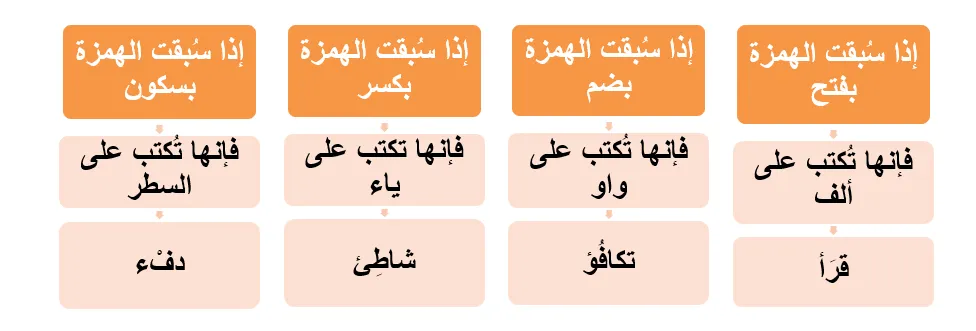Introduction:
This section talks about the End Hamza, its definition, its types, and explains how to write it correctly with examples for each type. It concludes with a diagram that summarizes the positions of the End Hamza.
Definition of the End Hamza:
The End Hamza is the hamza that comes at the end of a word, such as: wudoo’ (وضوء) – bada’a (بدأ) – qāri’ (قارئ) – lu’lu’ (لؤلؤ).
The Four Types of the End Hamza:
- End Hamza on Alif, such as: nasha’a (نشأَ)
- End Hamza on Waw, such as: bu’bu’ (بؤبؤ)
- End Hamza on Ya, such as: shāti’ (شاطئ)
- End Hamza on the line, such as: samā’ (سماء)
How is the End Hamza Written?
The method of writing the End Hamza is very simple:
| It is written on the letter that corresponds to the short vowel (harakah) of the letter that comes right before it, as follows: أ- If preceded by fatha, it is written on Alif; for example: mabda’ (مبدَأ) ب- If preceded by kasra, it is written on Ya; for example: bāri’ (بارِئ) ت- If preceded by damma, it is written on Waw; for example: takāfu’ (تكافُؤ). ث- If preceded by a sukoon, whether the letter is consonant or long vowel, it is written on the line; for example: jā’a (جاء), yudee’ (يضيء). |
Additional Examples of the End Hamza:
– “By the sky and He who constructed it” (Qur’an).
– “There is not a thing except that it exalts Him with praise, but you do not understand their glorification” (Qur’an).
– In accidents, the wounded are taken immediately to the emergency department in the hospital.
– May Allah protect you from the harm of delay in supporting the oppressed.
| Note– How is the End Hamza written when a pronoun is attached to it? |
| If a pronoun is attached to the End Hamza, it changes from an End Hamza into a Middle Hamza. In that case, the rules of the Middle Hamza apply. For example: du‘ā’ → du‘ā’uhu (دعاؤه) du‘ā’unā (دعاؤنا) du‘ā’inā (دعائنا) As in the Qur’anic verse: “Indeed, these love the immediate and leave behind them a heavy Day.” In waraa’ahum (وراءَهم): the hamza is written as a Middle Hamza on the line, because a pronoun (hum) was added to the word that originally ended with an End Hamza. It became medial, open (with fatha), after a long vowel alif sakin. |
Conclusion:

Summary table of the End Hamza rule

